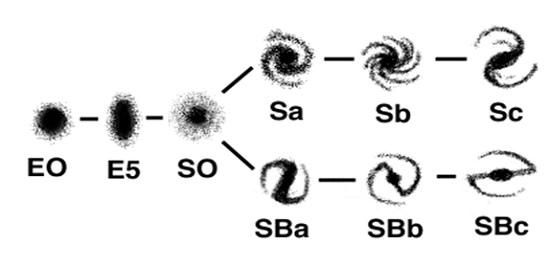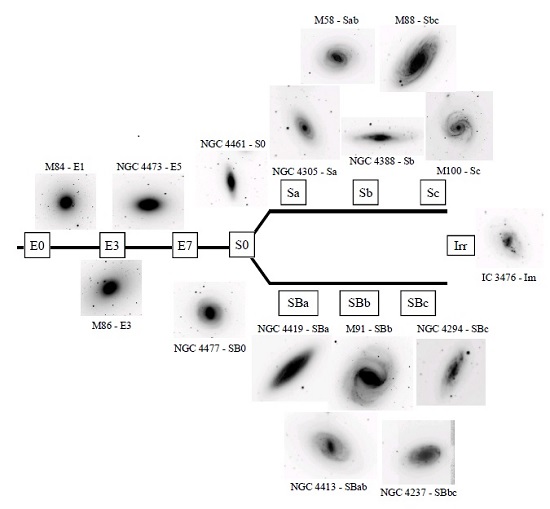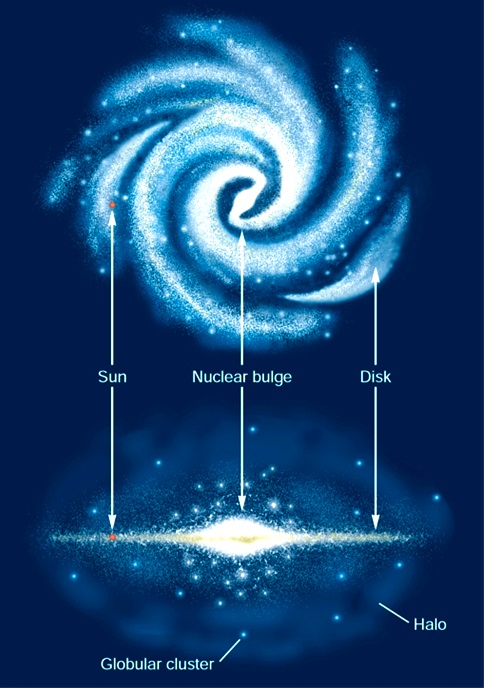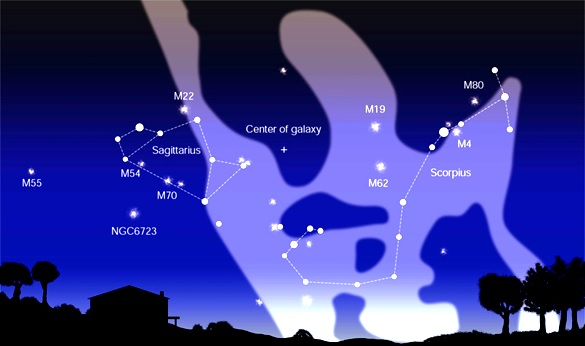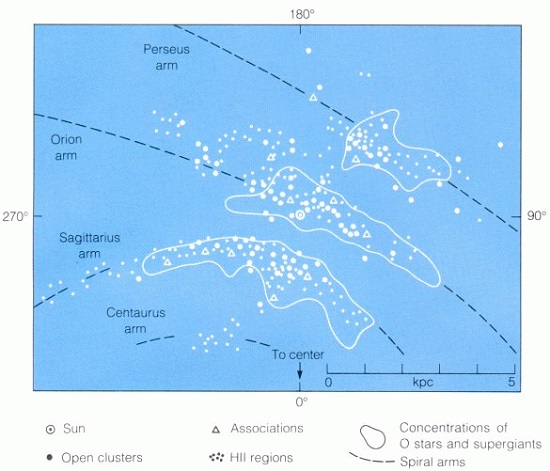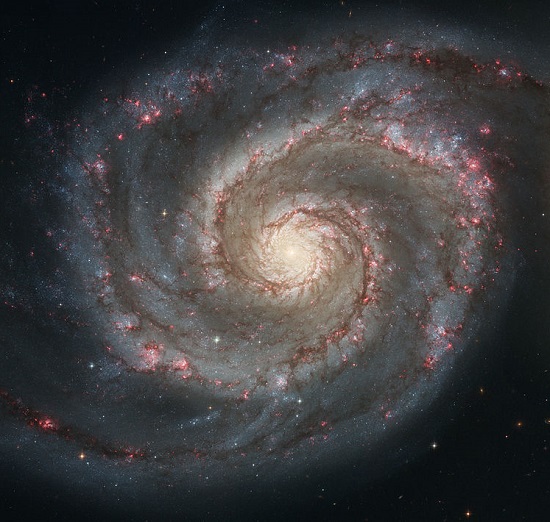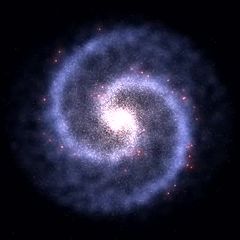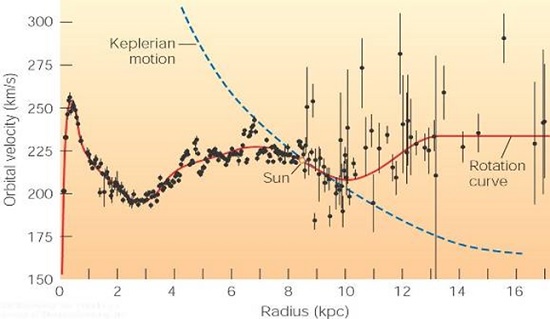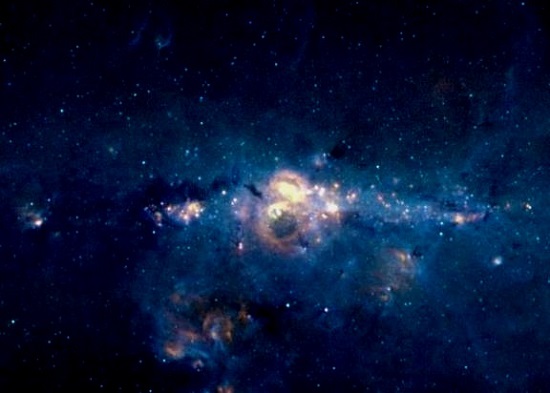I2AO Part 3: Galaxies and the Milky Way
Back to the Index of I2AO (Introduction to Astronomy Online)
PART 3: GALAXIES AND THE MILKY WAY by Lesa Moore
- What is a Galaxy?
- Galaxy classification
- Structure of the Milky Way
- Density Wave Theory explains Spiral Arms
- Rotation Curves point to Dark Matter
- Supermassive Black Hole at the Centre of the Milky Way
-----------------------------------------------------
- A galaxy is a collection of billions of stars.
- Each galaxy is unique.
- Galaxies display a wide variety of luminosities, sizes, masses and evolutionary states.
- They may be isolated or occur in groups, clusters or superclusters.
- Edwin Hubble, in the early 1920s, noted many sizes and shapes of galaxies.
- Common morphological forms are ellipticals, spirals, barred spirals, lenticulars and irregulars.
- Ellipticals generally contain mainly older stars and little gas. They have the largest range of sizes from dwarf to giant.
- Spirals contain older stars in the central bulge and younger stars, gas and dust in the disc, where ongoing star formation occurs.
- Barred spirals have an elongated central bulge, with the spiral arms extending from the tips of the bar.
- Lenticulars have a central bulge and a disc, but no spiral arms. They are at the transition between elliptical forms and spiral forms.
- Irregulars are the smallest galaxies, without any particular form or structure.
- Hubble was the first to describe galaxies according to shape and to provide a basic classification scheme still used today, known as the Hubble Tuning Fork Diagram.
- Hubble thought that galaxies evolved from elliptical to spiral. However, this is now known not to be the case.
Figure 1 below: A simple version of the Hubble Tuning Fork Diagram.
Image Credit: Montana State University
Figure 2 below: A version of the Hubble Tuning Fork Diagram illustrated with images of galaxies in the Virgo Cluster from "An ultra-deep survey of low surface brightness galaxies in Virgo" by Lesa (Elizabeth) Moore.
Image Credit: Lesa Moore
- The Milky Way is a barred spiral galaxy. Its overall size is at least 100,000 light years across. It contains something like 100 to 400 billion stars. Components of its structure are the central (or nuclear) bulge, the disk and the halo.
- The central bulge contains mainly older stars and little gas. It measures something like 15,000 light years across.
- The disc contains the spiral arms that, in turn, contain stars of all ages, stellar associations, open clusters, nebulae (including star-forming regions), and dust and gas (known as the interstellar medium, or ISM). The disc is only about 1000 light years thick.
- The halo is more-or-less spherical, with a similar diameter to the disc, and contains the globular clusters.
- Globular clusters orbit the centre of the galaxy in random orbits that my cross the disc. As stars in the disc orbit the centre of the galaxy, they remain within the disc.
- We view the galaxy from within, hence it appears as a band of light across the night sky. In the direction of Sagittarius, we are looking towards the galaxy centre (and may see the overall shape of the central bulge). In the direction of Orion, we are looking towards the edge.
- When we attempt to observe the centre of the Milky Way in optical light, our view is obscured by dust.
- Far-infrared observations are able to trace out the dust in the spiral arms of the galaxy, as well as the central bar.
- The following images illustrate various aspects of the Milky Way.
Figure 3 below: The overall structure of the Milky Way and the position of the Sun, some 28,000 light years from the centre.
Image Credit: Unavailable
Figure 4 below: The position of the centre of the Milky Way (marked +), with respect to the constellations of Scorpius and Sagittarius.
Image Credit: "Horizons: Exploring the Universe" by Michael A. Seeds
Figure 5 below: A photograph covering the centre of the Milky Way (circled), the "spout" of the "teapot" of Sagittarius (shown by the thin black lines) and the tip of the tail of Scorpius. Dust obstructs our view to the centre of the Milky Way.
Image Credit: Unavailable
Figure 6 below: Some detail of the spiral arm structure of the Milky Way, identified using optical observations. The Sun is indicated at the centre of the diagram and, beyond the regions shown, our view of the disc is obscured by dust and foreground stars.
Image Credit: University of Oregon
Figure 7 below: A photograph of M51, a face-on spiral galaxy. If we could view the Milky Way from outside, it may look something like M51. In this image, dust shows up as dark streaks, pink regions are emission nebulae in star-forming regions and the blue areas contain hot, young stars. The yellowish colour of the central bulge indicates an older population of stars.
Image Credit: NASA and ESA
Figure 8 below: A diagram of our galaxy constructed using far infrared observations of dust. Notice the location of the Sun at the edge of a spiral arm.
Image Credit: Michael A. Seeds
4. Density Wave Theory explains Spiral Arms
- Lin & Shu, in 1964, theorised that the spiral arms in spiral galaxies are density waves. In this theory, the spiral arms do not rotate, but appear as standing waves with higher densities of stars. Stars orbiting the centre of the galaxy move on elliptical orbits through the spiral arms, into the regions between and back into the spiral arms.
- There is a simulation that illustrates this effect on Wikipedia here: https://en.wikipedia.org/wiki/Density_wave_theory
Figure 9 below: Still shot from a simulation of a spiral galaxy, maintaining the spiral arms in fixed locations even though the stars move through them as they orbit the centre of the galaxy
Image Credit: The simulation is here - https://en.wikipedia.org/wiki/Density_wave_theory
5. Rotation Curves point to Dark Matter
- Different types of rotation are illustrated in Figure 10.
- Solid-body rotation is what you would expect from a bicycle wheel or any other fixed, spinning structure.
- Keplerian rotation or planetary rotation is what we observe within the Solar System - planets close to the Sun orbit fast, planets distant from the Sun orbit slower. The speed of the orbit is determined by the laws of gravity. When closer to a gravitational mass, you need to go faster to avoid falling into it.
Figure 10 below: Wheel-like (solid-body) rotation with planet-like (Keplerian) rotation.
Image Credit: University of Oregon
- When studies have been made of the rotation of the Milky Way, it has been found that, rather than conforming to Keplerian (planet-like) rotation, the outer parts of the galaxy are orbiting faster than expected. Hence, the galaxy must contain considerable 'unseen' mass outside the solar orbit, preventing the fast-moving outer stars from flying off into space.
Figure 11 below: Rotation curve for the Milky Way galaxy. Data points show measurements from optical and radio telescopes with uncertainties plotted as error bars. Note that the fitted rotation curve (red line) does not decline outside the Sun’s orbit as we would expect for Keplerian motion (dashed line). This indicates that there is dark matter surrounding the Milky Way.
Image Credit: Unavailable
6. Supermassive Black Hole at the Centre of the Milky Way
- We are not able to directly observe the centre of the Milky Way in optical light due to intevening dust.
- Infrared radiation penetrates dust, meaning that we are able to observe the centre of our galaxy at various infrared wavelengths.
- Observations in infrared have been made of stars orbiting close to the gravitational centre of the Milky Way, a point known as SgrA* (spoken "Sagittarius A star"). SgrA* gives off no light and is a very compact object that interacts with objects around it through gravity. Analysis of the orbits of these stars indicate that SgrA* is, in fact, a supermassive black hole with a mass of four billion solar masses.
Figure 12 below: Image of the centre of the Milky Way constructed using data from the Midcourse Space Experiment (MSX) satellite. It maps three MIR wavelengths into blue, green, and red revealing thermal emission from dust clouds near the galactic center that have been heated by starlight.
Image Credit: NASA
Figure 13 below: The orbit of S2 (Source 2) around SgrA*.
Image Credit: Nature
There is a GIF time-lapse showing some of the stars orbiting SgrA* available here: https://universe-review.ca/I05-01-SgrA.gif
Author: Lesa Moore, 26 July 2017. Minor revisions 28th January 2018.

